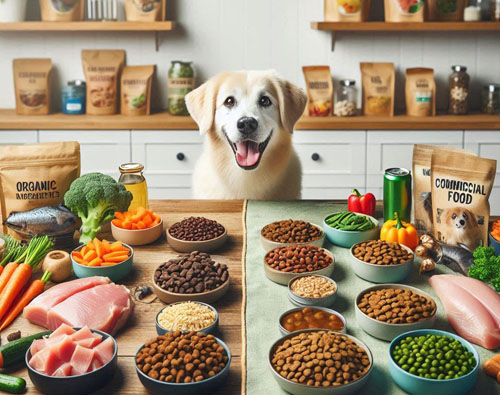Choosing the right food for your dog is crucial for their health, energy levels, and longevity. Pet owners often debate whether organic or commercial dog food is the better choice. Both have their benefits and drawbacks, and the best option depends on your dog’s specific needs. Let’s explore the key differences to help you make an informed decision.
🥦 What is Organic Dog Food?
Organic dog food is made from natural ingredients without artificial chemicals, pesticides, or synthetic additives. It usually contains high-quality meats, grains, and vegetables that are grown or raised without harmful substances.
✅ Benefits of Organic Dog Food
- Free from Harmful Additives – No artificial colors, preservatives, or chemicals.
- Better Nutritional Value – Often contains more vitamins, minerals, and antioxidants.
- Easier Digestion – Natural ingredients reduce the risk of food allergies and digestive issues.
- Supports Overall Health – Helps improve skin, coat, and immune system function.
- Sustainability – Eco-friendly farming methods are used in production.
❌ Drawbacks of Organic Dog Food
- Higher Cost – Organic ingredients are more expensive than conventional ones.
- Shorter Shelf Life – No preservatives mean it may spoil faster.
- Limited Availability – Fewer options in pet stores compared to commercial brands.
🏪 What is Commercial Dog Food?
Commercial dog food is mass-produced and widely available. It comes in different forms, such as dry kibble, wet food, and semi-moist food. Many well-known brands follow industry standards to ensure balanced nutrition.
✅ Benefits of Commercial Dog Food
- Convenient and Affordable – Easily accessible in stores and online at various price points.
- Long Shelf Life – Contains preservatives to maintain freshness for longer.
- Nutritionally Balanced – Formulated with the right mix of proteins, carbs, vitamins, and minerals.
- Variety of Choices – Available in different flavors, ingredients, and special formulas for specific dog needs.
❌ Drawbacks of Commercial Dog Food
- May Contain Fillers and Additives – Some brands use artificial preservatives, colors, and low-quality by-products.
- Potential Allergens – Certain ingredients like corn, wheat, or soy may cause allergies in sensitive dogs.
- Risk of Low-Quality Ingredients – Not all brands use high-quality meat or grains, leading to possible nutritional deficiencies.
🧐 Which One Should You Choose?
The decision depends on your dog’s health, dietary needs, and your budget. Here’s a quick comparison:
| Feature | Organic Dog Food | Commercial Dog Food |
|---|---|---|
| Ingredients | Natural, chemical-free | May contain preservatives & fillers |
| Nutrition | Higher in nutrients | Balanced but varies by brand |
| Price | More expensive | Budget-friendly options available |
| Shelf Life | Shorter | Longer |
| Availability | Limited | Widely available |
👨⚕️ Expert Tip:
If your dog has food allergies, skin issues, or digestion problems, organic food may be the better choice. However, if convenience and affordability are priorities, commercial dog food from a trusted brand can still provide complete nutrition.
🔍 Final Verdict: Which is Better?
There is no one-size-fits-all answer! The best dog food is the one that meets your pet’s unique needs. Some pet owners prefer organic food for its natural benefits, while others rely on commercial food for affordability and convenience. You can also consider mixing both for a balanced approach!
🐶 No matter what you choose, always check ingredient labels, consult your vet, and ensure your dog is getting high-quality, nutritious food.
💬 What do you feed your dog? Share your thoughts in the comments!




